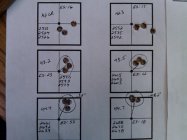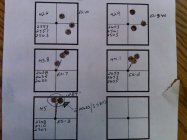I posted here last week with a few questions about some load development I was doing for a new rifle. Well, I made some changes to my process, gathered some more data, did more research, and came up with some new development data. I measured my free bore length in my rifle using the sinclair measuring tool and loaded all these ruonds at a .010" jump. Here are the specs on the rifle:
Surgeon Short Action
24" Krieger SS barrel MTU contour 1-11" twist
Sits in a AICS 2.0 stock
Jewell trigger, harris bipod, NF NXS 5.5-22x
I loaded all the rounds in fully prepped 1x fired Lapua cases, trimed to 2.005, neck sized with a .336 redding comp busing die. Using Wolf primers, Varget, and 175 gr Sierra SMK's. Target shot at a 100yd indoor range, chrono 10ft ahead.
I loaded ammo ranging in charge weight from 42 grs to 45 grains of Varget in .3 gr increments, giving me 11 sets total, three cartridges per set for a total of 33 rounds. I followed the Instructions to the OCW method ( http://optimalchargeweight.embarqspace.com/#/ocw-instructions/4529817134)
and tried to be as "scientific as possible". I shot two fouler shots and proceeded with my testing allowing 2 minuted between shots. It was fairly cool (59f) so barrel heating wasn't an issue. What I found was interesting. Around 42 grs the groups were wide open and as the charge weight progressed the groups tightened up. I know the OCW method is used to help select a "forgiving" node that will allow for some vairance in your loads, location, etc and still maintain a consistent POI, but I couldnt help but notice the group size.
The best groups by far came from the 45gr Varget, measured just above .25 MOA. I checked everything I know how to see if there were pressure issues with this load but couldnt find any - no hard bolt lift, no excessive head / case expansion (measured with calipers) and the primers were flat, but no flatter than the loads with the 43.8 grs.
Is this a common load, or too hot???
Now that I am at this point, where should I turn next to squeeze the last bit of accuracy out of this rifle and which powder charge looks good?
Here are the chrono data:
ES SD AVG HI LO
42 16 8.718 2520 2526 2510
42.3 17 8.544 2543 2552 2535
42.6 10 5.033 2558 2563 2553
42.9 42 23.692 2576 2603 2561
43.2 23 12.288 2579 2593 2570
43.5 12 6.928 2607 2615 2603
43.8 7 3.606 2631 2635 2628
44.1 2 1.155 2654 2655 2653
44.4 53 26.627 2664 2692 2639
44.7 18 9.018 2679 2688 2670
45 3 1.528 2708 2710 2707
Pics of the groups are below. As you can see, 44.1 and 45 grs both had insanely low velocity variations. When I charted this, there is actually a pattern of peaks and valleys, but the peak and valleys turn steeper as the velocuty / charge weight increases.
Thanks in advance!
This is becomming addicting!
Surgeon Short Action
24" Krieger SS barrel MTU contour 1-11" twist
Sits in a AICS 2.0 stock
Jewell trigger, harris bipod, NF NXS 5.5-22x
I loaded all the rounds in fully prepped 1x fired Lapua cases, trimed to 2.005, neck sized with a .336 redding comp busing die. Using Wolf primers, Varget, and 175 gr Sierra SMK's. Target shot at a 100yd indoor range, chrono 10ft ahead.
I loaded ammo ranging in charge weight from 42 grs to 45 grains of Varget in .3 gr increments, giving me 11 sets total, three cartridges per set for a total of 33 rounds. I followed the Instructions to the OCW method ( http://optimalchargeweight.embarqspace.com/#/ocw-instructions/4529817134)
and tried to be as "scientific as possible". I shot two fouler shots and proceeded with my testing allowing 2 minuted between shots. It was fairly cool (59f) so barrel heating wasn't an issue. What I found was interesting. Around 42 grs the groups were wide open and as the charge weight progressed the groups tightened up. I know the OCW method is used to help select a "forgiving" node that will allow for some vairance in your loads, location, etc and still maintain a consistent POI, but I couldnt help but notice the group size.
The best groups by far came from the 45gr Varget, measured just above .25 MOA. I checked everything I know how to see if there were pressure issues with this load but couldnt find any - no hard bolt lift, no excessive head / case expansion (measured with calipers) and the primers were flat, but no flatter than the loads with the 43.8 grs.
Is this a common load, or too hot???
Now that I am at this point, where should I turn next to squeeze the last bit of accuracy out of this rifle and which powder charge looks good?
Here are the chrono data:
ES SD AVG HI LO
42 16 8.718 2520 2526 2510
42.3 17 8.544 2543 2552 2535
42.6 10 5.033 2558 2563 2553
42.9 42 23.692 2576 2603 2561
43.2 23 12.288 2579 2593 2570
43.5 12 6.928 2607 2615 2603
43.8 7 3.606 2631 2635 2628
44.1 2 1.155 2654 2655 2653
44.4 53 26.627 2664 2692 2639
44.7 18 9.018 2679 2688 2670
45 3 1.528 2708 2710 2707
Pics of the groups are below. As you can see, 44.1 and 45 grs both had insanely low velocity variations. When I charted this, there is actually a pattern of peaks and valleys, but the peak and valleys turn steeper as the velocuty / charge weight increases.
Thanks in advance!
This is becomming addicting!












